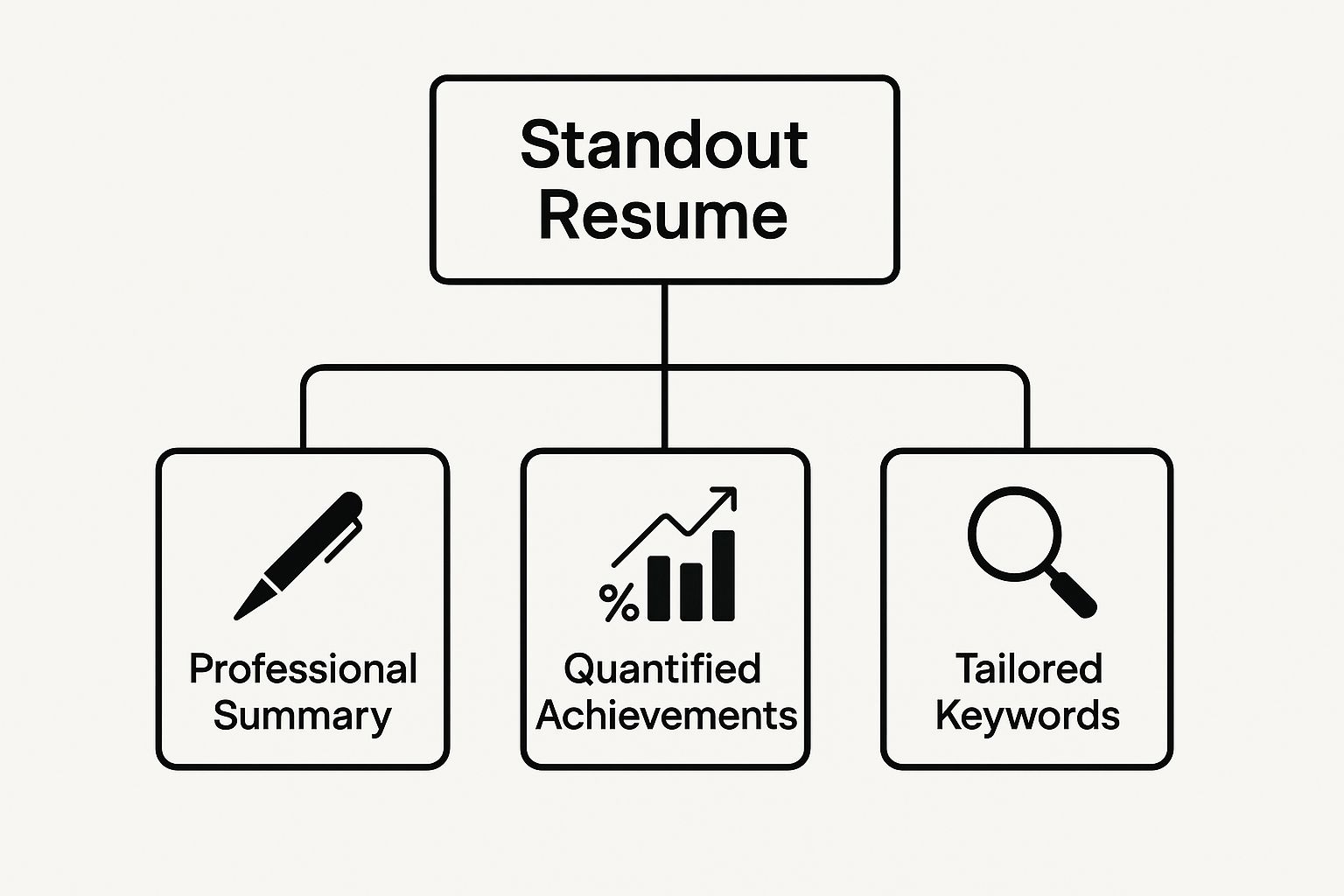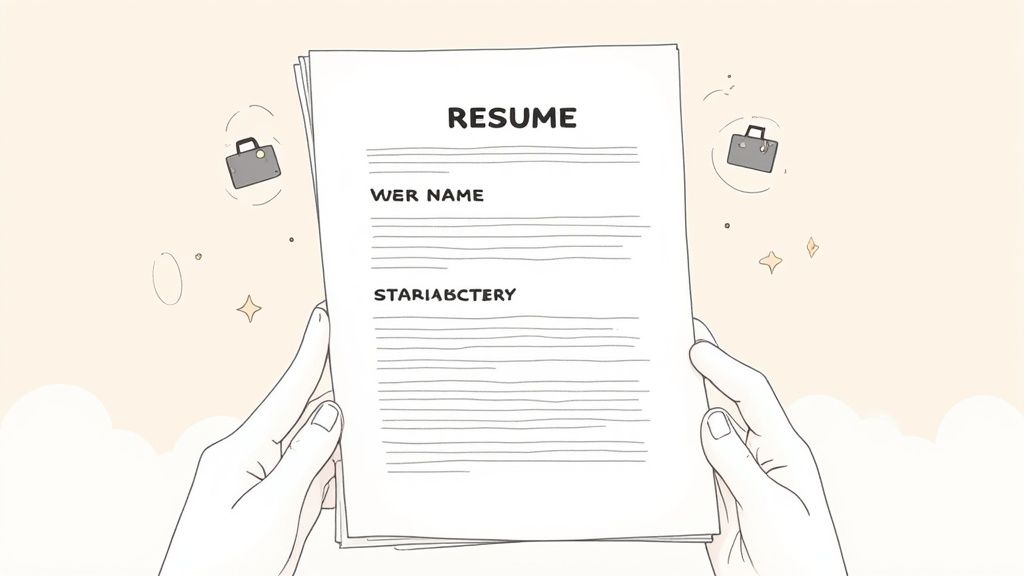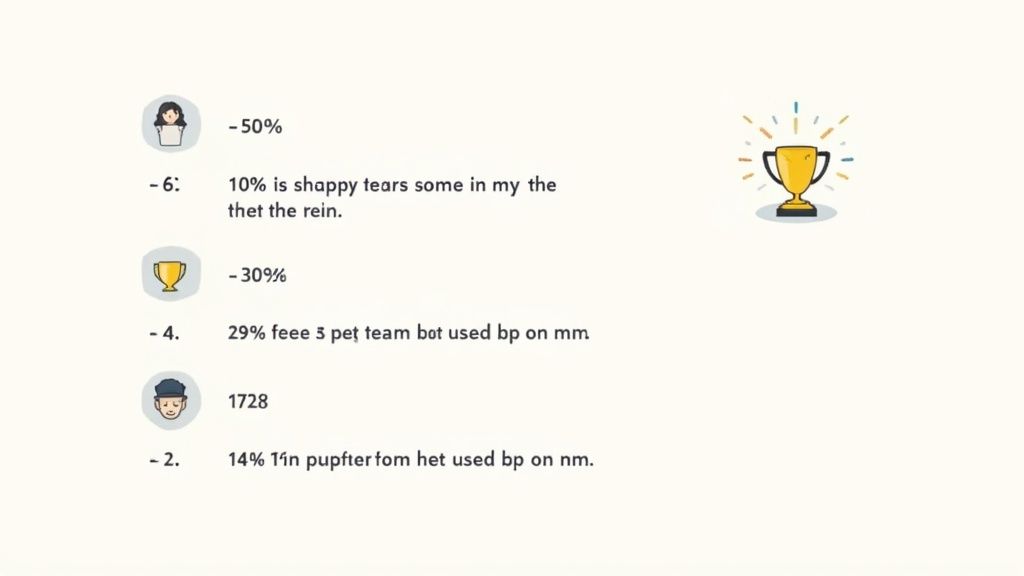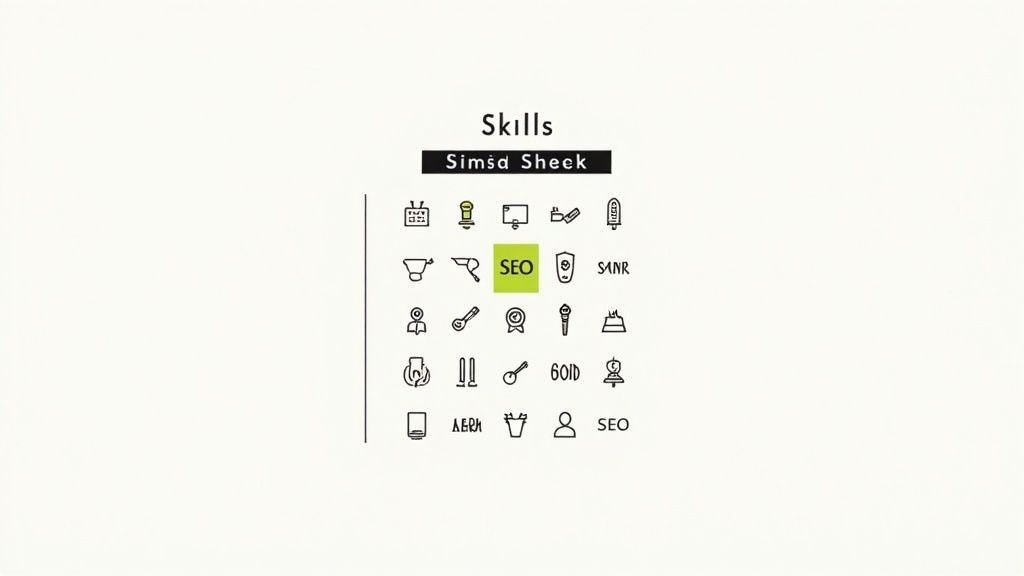
What Makes Resume Stand Out to Recruiters - Tips & Tricks
So, what really makes a resume catch someone’s eye? It’s a blend of two things: being technically sound enough to get past the software and persuasive enough to hook a human. Think of it as needing a “digital key” for the automated gatekeeper and a compelling story for the person on the other side.
Passing the Robot and Impressing the Recruiter
In today’s hiring world, your resume has to win over two very different audiences before you even get a chance at an interview. First up is the digital bouncer—the Applicant Tracking System (ATS). If you make it past that, you then have just a few seconds to grab the attention of a real person who’s sifting through a mountain of applications.
Let’s be honest, just listing your old job duties isn’t going to cut it anymore.
The first hurdle is purely technical. A whopping 90% of companies now rely on an ATS to do the initial screening. These systems aren’t wowed by fancy graphics or creative layouts. They are programmed to look for specific keywords, a clean structure, and standard formatting. This is a bigger deal than you might think—an incredible 75% of resumes get rejected by an ATS before a human ever sees them, often due to simple formatting mistakes. For a deeper dive, The Interview Guys offer great insights on resume formats.
This is precisely why you have to build your resume with both audiences in mind right from the start.
The Two-Fold Mission of Your Resume
To craft a resume that actually works, you need to zero in on two equally important goals:
- Beating the Bot: This is all about ATS compliance. Use standard fonts (like Calibri or Arial), clear headings (like “Work Experience”), and sprinkle in keywords pulled directly from the job description. This is the technical groundwork for your success.
- Engaging the Human: Once you’re past the software, your resume needs to tell a quick, powerful story about who you are and what you can do. This is where a sharp professional summary, action-packed language, and quantified results come into play. Show them your value, don’t just tell them.
The image below breaks down the key elements that help you accomplish both of these goals.

As you can see, a strong summary, achievements backed by real numbers, and carefully chosen keywords are the cornerstones of a resume that gets results.
To really nail this, it helps to see how each part of your resume serves both the software and the human reader.
Key Elements for a Standout Resume
| Element | Why It Matters for ATS | Why It Matters for Recruiters |
|---|---|---|
| Relevant Keywords | The ATS scans for keywords from the job description to score your resume’s relevance. No match, no pass. | Keywords quickly show the recruiter you have the specific skills and experience they’re looking for. |
| Standard Formatting | Clean, simple layouts with standard fonts and clear headings are easy for the software to parse and categorize. | An organized, easy-to-scan format lets them find the most important information in seconds. No one likes a cluttered mess. |
| Quantified Achievements | Numbers and data points are often read as keywords, especially when tied to key skills (e.g., “increased sales by 15%”). | Concrete numbers provide powerful proof of your impact and value. “Increased sales” is good; “Increased sales by 15%” is memorable. |
| Professional Summary | This section is a prime spot for high-value keywords that align with the core requirements of the role. | It’s your 30-second elevator pitch. A compelling summary grabs their attention and makes them want to keep reading. |
Ultimately, the best resumes are built with this dual purpose in mind from the very first word.
Tailoring Your Resume for Each Application
Sending the same resume out for every single job application is one of the biggest mistakes you can make. It’s like trying to unlock a door with the wrong key—it just won’t work. To really get a recruiter’s attention, you have to move past the “one-size-fits-all” mindset and create a document that speaks directly to the job you’re applying for. This doesn’t mean writing a new resume from scratch every time, but it does mean having a smart, repeatable process.
Think of the job description as your roadmap. Your first job is to break it down and find all the clues about what the employer really wants. Look for keywords that pop up again and again, scan the “Requirements” section for essential skills, and even look for hints about the company culture in the language they use. Getting this initial analysis right is the foundation for everything that follows.

Mirroring the Employer’s Language
Once you’ve identified what they’re looking for, the next step is to weave that same language into your resume. This is where you transform your application from a generic history of your past jobs into a direct solution to the company’s problem.
- Professional Summary: Tweak your opening statement to lead with the most important qualifications from the job post. If they’re looking for a “data-driven marketer,” your summary better mention your data analysis skills right away.
- Work Experience: Rephrase your bullet points. Use the same action verbs and terminology you found in their description. Don’t just list what you did; show how your accomplishments directly line up with what they need now.
- Skills Section: Reorder your skills list to feature the ones they specifically asked for at the top. If “Salesforce proficiency” is a must-have, make sure it’s impossible to miss.
For a deeper dive, our guide on how to tailor your resume to a job description breaks this down step-by-step. This deliberate fine-tuning is what makes a recruiter stop and think, “This person gets it.”
Why This Extra Effort Matters
In today’s job market, this level of customization isn’t just a nice-to-have; it’s essential. Recruiters can spot a generic resume from a mile away, and those often end up in the ‘no’ pile without a second thought.
A targeted resume shows you’ve done your homework and are genuinely invested in the opportunity. It communicates respect for the recruiter’s time and a clear understanding of the role’s demands.
The numbers back this up, too. A recent survey found that a staggering 83% of recruiters worldwide prefer candidates who customize their resumes. Think about that—you’re immediately putting yourself in the top tier just by making a few strategic edits.
And it’s not just about keywords. Even the length of your resume plays a huge role. The sweet spot is between 475 and 600 words. Anything outside that range? It has a success rate of less than 5%.
By taking a few extra minutes to align your resume with each job, you’re doing more than just trying to beat a computer scan. You’re building a compelling case for why you are, without a doubt, the right person for the job. That simple shift makes all the difference.
Turning Responsibilities Into Achievements
Here’s one of the biggest and most effective changes you can make to your resume: stop listing what you were supposed to do and start showcasing what you actually did. This is a game-changer. Recruiters aren’t interested in your job description; they want to see the impact you made.
Think about it. A responsibility is just the baseline. “Managed social media accounts” tells a hiring manager what was expected of you. But an achievement—like “Grew social media engagement by 45% in six months”—tells them you delivered real value. One is a task, the other is a result.

When you make this shift, you’re not just listing duties anymore. You’re building a compelling case for why you’re the right person for the job, backed by hard evidence.
The Achievement Formula
There’s a simple formula I always recommend for crafting bullet points that get noticed. It forces you to think like a hiring manager and focus on what matters most.
Action Verb + Quantifiable Result + Context
Let’s see this in action. It’s the difference between a flat statement and a mini-story of your success.
- Before: “Responsible for customer support tickets.”
- After: “Resolved an average of 50+ customer support tickets daily, exceeding team targets by 15% through a streamlined issue-tracking process.”
See the difference? The “after” version kicks off with a strong action verb (“Resolved”), backs it up with hard numbers (“50+”, “15%”), and gives context that shows how you did it. It transforms a passive duty into a powerful accomplishment. For more ideas like this, check out our guide on the best resume writing tips.
How to Find Your Numbers
“But I don’t have exact metrics!” This is a hurdle almost everyone faces, but don’t worry. You can usually find or logically estimate your impact without making things up. It just takes a bit of digging.
Here are a few ways to uncover those numbers:
- Estimate Scope: Think about scale. How many clients did you work with? How many articles did you publish each month? What was the size of the budget you helped manage?
- Show Frequency: How often did you perform a critical task? “Conducted daily security audits” sounds much more proactive than just “Responsible for security.”
- Highlight Efficiency: Did you make something faster or cheaper? Think in terms of time or money saved. For example, “Reduced project reporting time by 5 hours per week by automating data entry.”
Focusing on your impact shows you’re a candidate who doesn’t just clock in and out. It proves you’re a problem-solver who actively drives success—and that’s exactly what gets your resume moved to the top of the pile.
Designing a Resume That’s Easy on the Eyes
Think of your resume’s content—your achievements and keywords—as the engine. It’s powerful, but it needs a solid chassis to hold it all together. That’s your layout. You could have the most impressive accomplishments in the world, but if they’re buried in a wall of tiny, cramped text, no one will stick around to find them.
The single most important goal of your resume’s design is readability. A recruiter or hiring manager gives it a quick glance—we’re talking just a few seconds—to make a snap judgment. Your layout’s job is to make that first scan as effortless as possible, guiding their eyes straight to your most compelling qualifications.
Simple is Smart
This isn’t the place for flashy designs, wild custom fonts, or infographics. Those things might look cool, but they often backfire, especially with Applicant Tracking Systems. These systems get confused by fancy tables, columns, and images, which can send your resume straight to the digital graveyard before a human ever sees it. A clean, single-column format is your safest and most effective bet.
Here’s how to nail the fundamentals:
- Pick a Professional Font: Stick with the classics like Calibri, Arial, or Georgia. They’re clean and easy to read. Keep your body text between a 10 and 12-point font size.
- Embrace White Space: Don’t be afraid of empty space on the page. Generous margins and breathing room between sections make your resume feel organized and much less intimidating to read.
- Create a Clear Hierarchy: Use bold text and a slightly larger font for your name and section headings (like “Work Experience” or “Education”). This creates a simple visual roadmap for the reader to follow.
A resume’s design should be invisible. If a recruiter notices your formatting before your accomplishments, the design has failed. The best layouts are clean, professional, and put the focus squarely on what you bring to the table.
For the vast majority of jobs, a straightforward and professional look wins every time. That said, the structure you choose can send a subtle message about your career path. Let’s break down the common formats and how they play with the ATS.
Resume Format Comparison for ATS Friendliness
The table below compares the most common resume formats and how well they work with the applicant tracking systems that screen your application.
| Format Type | ATS Compatibility | Best For | Key Consideration |
|---|---|---|---|
| Reverse-Chronological | Excellent | Nearly all professionals; it highlights a clear career progression. | This is the industry standard and the format recruiters expect to see. |
| Functional (Skills-Based) | Poor | Career changers or those with significant employment gaps. | Often flagged by ATS and viewed suspiciously by recruiters; use with extreme caution. |
| Combination (Hybrid) | Good | Experienced professionals with a diverse skill set to showcase. | Can be effective but requires careful formatting to remain scannable and clear. |
In the end, the reverse-chronological format is almost always the right choice. It’s what both recruiters and the software are built to understand, ensuring your hard work gets the attention it deserves.
Writing a Powerful Professional Summary
Think of your professional summary as the trailer for your career. It’s the very first thing a recruiter reads, and in just a few seconds, it has to convince them that the rest of the movie—your resume—is worth their time. This short, 3-4 sentence paragraph is your 30-second elevator pitch, strategically placed right at the top to make an immediate, powerful impression.
This summary isn’t just a simple introduction; it’s your best tool for framing your entire application. It’s your one shot to boil down years of experience, shine a spotlight on your most relevant skills, and showcase your biggest wins in a tight, compelling story. A killer summary tells the hiring manager that you aren’t just another applicant—you’re the solution they’ve been looking for.

Crafting Your Hook
To write a summary that actually grabs attention, you have to be selective. Don’t make the mistake of trying to cram your entire life story into it. The key is to focus only on the qualifications and achievements that line up perfectly with the job you’re targeting. This is what separates a good resume from a great one.
Here’s a simple, field-tested structure that works every time:
- Your Professional Title: Kick things off with your current or desired title and years of experience. For example, “Data Analyst with 5+ years of experience…”
- Key Skills: Name drop 2-3 of your core skills that are a dead ringer for what the job description asks for. Something like, “…specializing in data visualization and predictive modeling.”
- Major Accomplishment: Seal the deal with a specific, quantified achievement that proves your value. For instance, “Proven ability to translate complex datasets into actionable insights, leading to a 15% increase in marketing ROI.”
This straightforward approach immediately tells the recruiter who you are, what you’re good at, and the kind of results you can bring to their team.
Examples for Different Career Stages
The focus of your summary should absolutely change depending on where you are in your career. A recent grad needs to sell their potential and academic wins, while a seasoned executive should be all about leadership and strategic impact.
For an Entry-Level Candidate: “Motivated Marketing graduate with a strong foundation in digital analytics and content creation. Eager to apply my skills in SEO and social media strategy to help drive brand growth. I recently led a university project that boosted student event attendance by 40% through a targeted digital campaign.”
For a Mid-Career Professional: “Results-driven Project Manager with 8+ years of experience leading cross-functional teams to deliver complex software projects on time and under budget. I have a deep expertise in Agile methodologies and risk management, with a track record of improving team efficiency by 25%. I’m passionate about building innovative solutions that go above and beyond what clients expect.”
See how both examples are specific and backed by a number? Moving from a vague, old-school objective statement to a powerful summary like this instantly elevates your resume, ensuring it gets the attention it deserves.
Speaking Their Language: Integrating Keywords and Skills Like a Pro
Think of an Applicant Tracking System (ATS) as a digital bouncer at an exclusive club. It has a very specific guest list, and if your name (or in this case, your resume) isn’t on it, you’re not getting in. The “guest list” is made up of keywords pulled directly from the job description.
This isn’t about just cramming in jargon. It’s about strategically speaking the employer’s language to show you’re the perfect fit before a human ever lays eyes on your application. Your first step is to dissect the job posting. Look for recurring words, specific software names, and essential qualifications—these are your golden keywords.
From there, you’ll want to weave them naturally throughout your professional summary, work experience, and, of course, a dedicated skills section.
Hard Skills vs. Soft Skills: What’s the Difference?
To really make your resume pop, you need to understand the two types of skills that recruiters and algorithms are scanning for. Both are critical, but they paint different pictures of who you are as a professional.
- Hard Skills are the technical, teachable abilities you bring to the table. They’re concrete and easy to measure—things like proficiency in Python, fluency in Spanish, or experience with Salesforce.
- Soft Skills are your people skills. They’re all about how you interact with others and navigate the workplace. Think communication, leadership, teamwork, and creative problem-solving.
A huge mistake I see people make is focusing only on their hard skills. Recruiters are just as interested in how you collaborate and lead. The goal is to present a balanced blend of both.
Smart keyword integration isn’t just a trick to beat a robot. It’s how you signal to a hiring manager, “I get it. I understand what this role needs, and I have what it takes.”
Putting Keywords Where They Count
Simply listing a skill isn’t enough. Where you place your keywords can make all the difference. An ATS often gives more weight to keywords that show up in the context of your work experience, not just in a laundry list at the bottom.
For instance, instead of just listing “Project Management” in your skills section, show it in action. Try something like this in a bullet point: “Spearheaded a cross-functional team using project management principles to deliver the final product two weeks ahead of schedule.” See the difference? One is a claim, the other is proof.
Getting this right is more important than ever. With 25% of organizations planning to adopt AI-powered ATS in the near future, the software is only getting smarter at parsing resumes for qualifications. While this helps reduce bias by focusing on pure skills, it also raises the bar for resume optimization.
By thoughtfully weaving the right mix of hard and soft skills throughout your resume, you build a document that sails through the initial screening and tells a powerful story to the hiring manager on the other side. To take this a step further, check out our guide on finding and using the right job search keywords.
Answering the Big Resume Questions
Let’s be honest, resume advice can feel all over the place. One “expert” says one thing, another says the complete opposite. It’s time to cut through the noise. Here are some no-nonsense answers to the questions I get asked most often.
How Long Should My Resume Be?
For almost everyone, one page is the answer. Think of it this way: recruiters are drowning in applications and spend mere seconds on their first look. A single, powerful page makes their job easier and ensures your most important achievements get seen immediately. It’s not about cramming everything in; it’s about being selective and impactful.
Of course, there are a few exceptions. You might need a two-page resume if:
- You’re a seasoned executive with 10-15+ years of deep, relevant experience.
- You’re in a field like academia or science where a long list of publications, patents, or research projects is standard.
- You’re applying for a federal government position, which often requires a more exhaustive work history.
Even then, never go beyond two pages. Brevity is your friend.
Should I Put a Photo on My Resume?
In places like the US, UK, and Canada, the answer is a hard no. Including a photo opens the door to unconscious bias, something most companies are actively trying to eliminate from their hiring process. You want to be judged on your skills and experience, not your appearance.
Beyond the bias issue, photos are a technical nightmare for Applicant Tracking Systems (ATS). The software can’t read images, which can cause it to scramble your information or even discard your application entirely. A clean, text-only resume is always the safer bet.
Is a Creative Resume a Good Idea?
This is a tricky one. If you’re a graphic designer, a visual resume can be a brilliant way to showcase your talent—it’s essentially a mini-portfolio. Your ability to present information beautifully is part of the job.
But for the vast majority of corporate roles? It’s a huge gamble. These highly formatted documents are often completely unreadable by ATS bots. Even if it gets past the software, a more conservative hiring manager might see it as unprofessional. Unless you’re in a creative field, a clean, well-structured, and easy-to-read resume will almost always serve you better.
Ready to build a resume that gets results without all the second-guessing? Jobcamp uses AI to instantly create resumes and cover letters designed to get past the bots and catch a recruiter’s eye. Stop stressing and start landing interviews. Try Jobcamp for free today and see the difference

